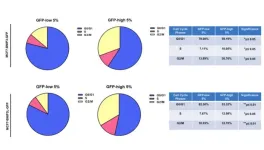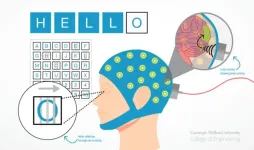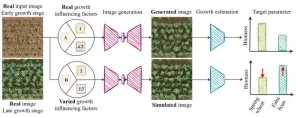(Press-News.org)
Poor diet continues to take a toll on American adults. It’s a major risk factor for obesity, type 2 diabetes, cardiovascular disease, and certain cancers, and more than one million Americans die every year from diet-related diseases, according to the Food and Drug Administration. Poor diet and food insecurity is also costly, attributing to an estimated $1.1 trillion in healthcare expenditures and lost productivity. These burdens also contribute to major health disparities by income, education, zip code, race, and ethnicity.
In a study from the Food is Medicine Institute at the Friedman School of Nutrition Science and Policy at Tufts University published today in the Annals of Internal Medicine, researchers found that diet quality among U.S. adults improved modestly between 1999 and 2020. However, they also found that the number of Americans with poor diet quality remains stubbornly high. Most notably, disparities persist and, in some cases, are worsening.
“While we’ve seen some modest improvement in American diets in the last two decades, those improvements are not reaching everyone, and many Americans are eating worse,” says Dariush Mozaffarian, cardiologist and director of the Food is Medicine Institute, and senior author on the study. “Our new research shows that the nation can’t achieve nutritional and health equity until we address the barriers many Americans face when it comes to accessing and eating nourishing food.”
In the study, researchers investigated data from 10 cycles of the National Health and Nutrition Examination Survey between 1999 and 2020, a nationally representative survey that includes repeated 24-hour dietary recalls, where people report all foods and beverages consumed during the prior day. The study analyzed 51,703 adults who completed at least one valid 24-hour recall, with 72.6% having done two recalls.
Diet quality was measured using the American Heart Association diet score, a validated measure of a healthy diet that includes components like fruits, vegetables, beans and nuts, whole grains, sugary beverages, and processed meat. Researchers found that the proportion of adults with poor dietary quality decreased from 48.8% to 36.7% over these two decades, while those with intermediate diet quality increased from 50.6% to 61.1%. They also found that the proportion of adults with an ideal diet improved but remained starkly low, from 0.66% to 1.58%.
Specific changes contributed to these trends, including higher intakes of nuts/seeds, whole grains, poultry, cheese and eggs. Researchers also found lower consumption of refined grains, drinks with added sugar, fruit juice and milk. Total intake of fruits and vegetables, fish/shellfish, processed meat, potassium, and sodium remained relatively stable.
When the analysis focused on key subgroups, the researchers found that these improvements were not universal. Gains in dietary quality were highest among younger adults, women, Hispanic adults, and people with higher levels of education, income, food security, and access to private health insurance. They were lower among older adults, men, Black adults, and people with lower education, less income, food insecurity, or non-private health insurance. For example, the proportion of adults with poor diet quality decreased from 51.8% to 47.3% among individuals with lower income, decreased from 50.0% to 43.0% among individuals with middle income, and decreased from 45.7% to 29.9% among individuals with higher income.
“While some improvement, especially lower consumption of added sugar and fruit drinks, is encouraging to see, we still have a long way to go, especially for people from marginalized communities and backgrounds,” adds first author Junxiu Liu, a postdoctoral scholar at the Friedman School at the time of the study, now assistant professor at the Icahn School of Medicine at Mount Sinai.
“We face a national nutrition crisis, with continuing climbing rates of obesity and type 2 diabetes,” Mozaffarian said. “These diseases afflict all Americans, but especially those who are socioeconomically and geographically vulnerable. We must address nutrition security and other social determinants of health including housing, transportation, fair wages, and structural racism to address the human and economic costs of poor diets.”
Citation: This research was supported by funding from the National Institutes of Health’s National Heart, Lung and Blood Institute under award R01HL115189. Complete information on authors, methodology, funders, and conflicts of interest is available in the published paper.
Disclaimer: The content is solely the responsibility of the authors and does not necessarily represent the official views of the funders.
END
A new aging atlas gives scientists an in-depth view of how individual cells and tissues in worms age and how different lifespan-extending strategies might stop the clock.
Aging impacts all the tissues in our body – from our muscles to our skin. Figuring out how individual tissues and cells age could help researchers better understand the aging process and aid in the development of anti-aging treatments.
Due to their short lifespans, simple body plans, and genetic similarity to humans, many researchers study aging in roundworms. To look at aging at the level of tissues and cells, a team of researchers from HHMI's Janelia ...
By Beth Miller
Human brain diseases, such as Parkinson’s disease, involve damage in more than one region of the brain, requiring technology that could precisely and flexibly address all affected regions simultaneously. Researchers at Washington University in St. Louis have developed a noninvasive technology combining a holographic acoustic device with genetic engineering that allows them to precisely target affected neurons in the brain, creating the potential to precisely modulate selected cell ...
Each of us individually is the accumulated product of thousands of generations that have come before us in an unbroken line. Our culture and technology today are also the result of thousands of years of accumulated and remixed cultural knowledge.
But when did our earliest ancestors begin to make connections and start to build on the knowledge of others, setting us apart from other primates? Cumulative culture — the accumulation of technological modifications and improvements over generations — allowed humans to adapt to a diversity of environments and challenges. But, it is unclear when cumulative culture first developed during hominin evolution.
A study published ...
“[...] our current work has provided a novel strategy to enrich for a sub-population of cancer cells, with high basal levels of mitophagy.”
BUFFALO, NY- June 17, 2024 – A new research paper was published on the cover of Aging (listed by MEDLINE/PubMed as "Aging (Albany NY)" and "Aging-US" by Web of Science) Volume 16, Issue 11, entitled, “Mitophagy and cancer: role of BNIP3/BNIP3L as energetic drivers of stemness features, ATP production, proliferation, and cell migration.”
Mitophagy is a selective form of autophagy which permits ...
Brain-computer interfaces or BCIs hold immense potential for individuals with a wide range of neurological conditions, but the road to implementation is long and nuanced for both the invasive and noninvasive versions of the technology. Bin He of Carnegie Mellon University is highly driven to improve noninvasive BCIs, and his lab uses an innovative electroencephalogram (EEG) wearable to push the boundaries of what’s possible. For the first time on record, the group successfully integrated a novel focused ultrasound stimulation to realize bidirectional BCI that both encodes and decodes brain waves using machine learning in a study with 25 human subjects. This work opens ...
Times of crises often call for strong and rapid action, but in polarized societies, strong top-down policies can backfire.
In a paper published on June 17, 2024, in Environmental Research Letters, SFI Applied Complexity Fellow Saverio Perri, SFI Science Board Fellow Simon Levin (Princeton University), and colleagues present a conceptual model of how these dynamics could play out in efforts to decarbonize our energy supply. The model illustrates the complex interplay between strong policies, people’s perception of risk, and the amount of polarization in a society. They show that in situations where the perception of risk is low — where the ...
Researchers at the University of Bonn have developed software that can simulate the growth of field crops. To do this, they fed thousands of photos from field experiments into a learning algorithm. This enabled the algorithm to learn how to visualize the future development of cultivated plants based on a single initial image. Using the images created during this process, parameters such as leaf area or yield can be estimated accurately. The results have been published in the journal Plant Methods.
Which plants should I combine ...
African research is receiving a major visibility boost with the indexing of 10 national funders in Dimensions, the world’s largest linked research database.
This project is a collaboration with Digital Science, the Africa PID Alliance (APA), the Association of African Universities (AAU), the Training Centre in Communication (TCC Africa), and the Research Organization Registry (ROR).
“This project connects the research outputs from leading African funding bodies to the global research ecosystem,” said Joy Owango, Executive Director of TCC Africa ...
FOR IMMEDIATE RELEASE
In studies with genetically engineered mice, Johns Hopkins Medicine researchers say they have identified a potentially new biological target involving Aplp1, a cell surface protein that drives the spread of Parkinson’s disease-causing alpha-synuclein.
The findings, published May 31 in Nature Communications, reveal how Aplp1 connects with Lag3, another cell surface receptor, in a key part of a process that helps spread harmful alpha-synuclein proteins to brain cells. Those protein buildups are hallmarks of Parkinson’s disease.
Notably, the researchers say, Lag3 is already the target of a combination ...
A first-of-its-kind study found high rates of food insecurity, housing insecurity, financial strain, and/or a lack of transportation among patients at federally qualified health centers, particularly patients who were low-income or from racial/ethnic minority populations.
Federally qualified health centers (FQHCs) offer primary care services to 1 in 11 Americans, the majority of whom are low-income and/or underinsured and may not otherwise receive this care. While prior research has shown that 70 percent of FQHCs screen for social ...





